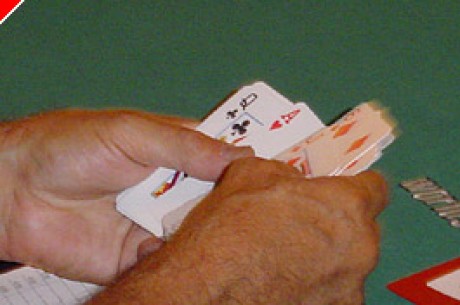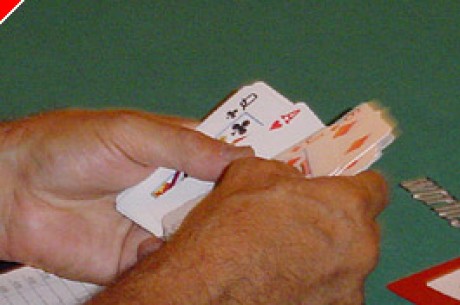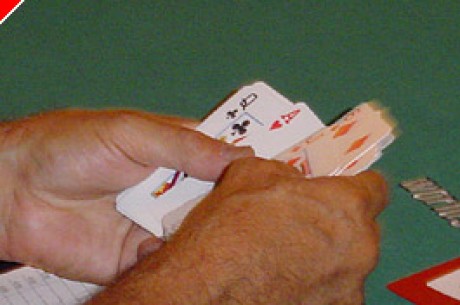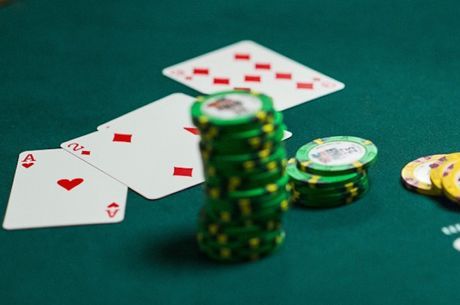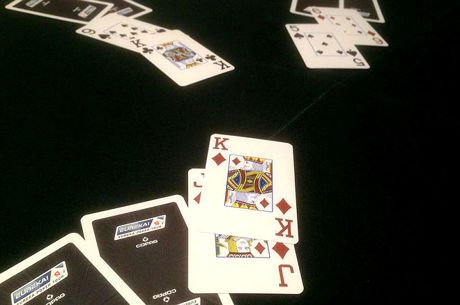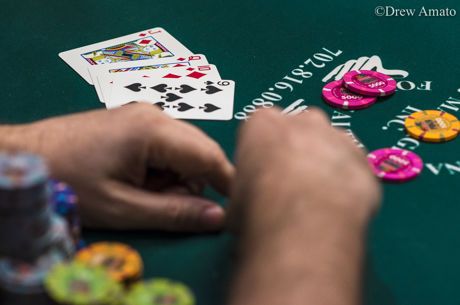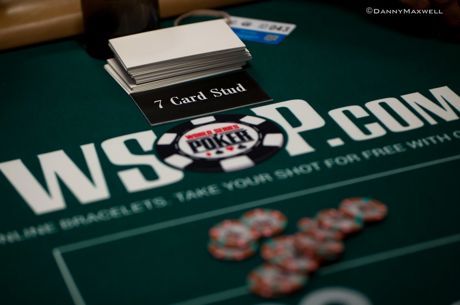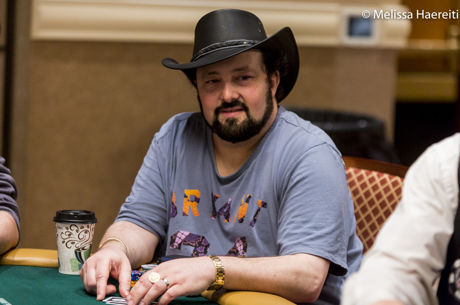Stud Poker Strategy - Stud 8 Sit n Go Strategy, Part One
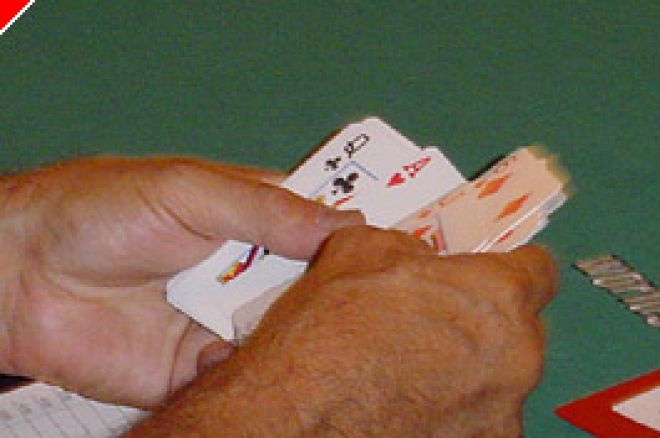
I like to play Stud8 (7-card Stud Hi-Lo, with an 8 low as a qualifier) on line sit and go tournaments. These are one or two table tourneys that begin as soon as the table (or tables) are full. They are usually between $5 and $20 for the stud8 events (there are many higher stakes ones for the hold 'em games) and they last about 90 minutes (if you win – less of course if you lose). They are a good and inexpensive way to try out your stud8 tourney skills. Let me tell you my basic strategy.
Depending upon the site, players begin with a stack of between $800 and $1500 with stakes of $15/30, with $2 antes and a $5 bring-in or slightly higher. They then progress rapidly, reaching $300/600 within an hour and a half or so. The Stud tourneys go up in stakes every ten hands or ten minutes or so, depending on the site.
The quality of players is typical very poor. These games are easy pickings if you play carefully. Here is a simple strategy to start off with. You can tailor it as you figure out your opponents. But this is a place to begin. I've finished in the money nearly every time I've played (85%) and I've won about 20% of my 20 or so entries.
Play tightly to start. Don't play any hands, absolutely none unless they have at least the following assets: 3 babes (A,2,3,4,5,6,7) preferably with an Ace if the pot is raised, a pair of Aces or a Premium Pair if they're wired and the kicker is a babe. You're not going to play these cards all the time either. You want to have all of your cards below the other babes if there's a raise. So if there's a 6 that's in the hand don't play a 7 for a raise (unless all the cards are suited or you have an Ace to go with it). Fold your pairs even if they're wired if a higher card raises. An exposed King raises and you have wired Queens? Fold that turkey.
If there are three or more babes exposed in ranks other than the ones you hold, fold the hand even for the bring in if there's a raise – unless you have three consecutive or one-gapped babes, or unless they're three wheel cards (A, 2, 3, 4, 5), or unless they're three suited cards, or unless they include an Ace (and there are no Aces exposed). So, if you have (4h6d) 7s and you see a 2, two 3s and a 4 and someone raises, fold your hand. You wouldn't mind if you saw a couple of 6s or 7s. It would be like seeing a card above an 8 because it's a card you don't want dealt to you anyway. You're not looking to pair one of your low cards. You're looking for a fourth and then a fifth low card –ideally making your straight in the process.
In general, play your low hands like you would play a draw – for a call or a check if there's been no betting to you. Players at this level often over play high hands. Let them – calling along on Third to encourage other high hands to draw. What you want is to get to Fourth cheaply – so you can cheaply see if you're able to get four to a low – ideally with a straight or flush draw to go with it. If you do then you're looking to bet and raise to knock out or extract more money from high hands while knocking out potential low draws so you're freerolling if you hit any low.
If, for example, you have hit on fourth (3c-2d) 4d6d and an AK bets and is called by a JhTh and a (xx) 4s9c remains then you want to raise. The 49 will probably fold – since he was probably on a low draw and hit a brick. The AK will probably call – unless he's a maniac or close to the felt (in which case he'll probably raise – in which case you just call). And the JhTh will either call for the single or double raise or fold – either of which is fine with you since he can't hurt you if you hit any low.
On Fifth Street you hope to hit a low. But even if you don't you're going to follow the same practice if the pot is more than two way. You'll raise or initiate the betting if there are three or more of you in – since the odds are that you'll hit a low. And with the added possibility that you'll hit a high as well and win high, you want the extra money in the pot. On the other hand, if it's heads up you just want to check and call – since you will probably end up splitting. You want to cheaply freeroll your high-only opponent, hoping to hit both high and low on Sixth or the River, in which case you will bet and raise until he calls you.
On Sixth Street, if you are still on a low draw, even if the pot is multi-way, you just want to check and call. And on the River, if you have hit any high hand even if you haven't hit a low you will call your opponent who is representing high unless his board beats your hand– just in case he is still betting a high draw but has missed. I say you will check and call – but if you have a low you will bet and raise – knowing that you will win half the pot with your low and all of the pot if your high beats your opponent's.
Here's an example of early sit and go play.
(xx)9
(xx)7
(xx)K
(xx)A
(xx)8
(4d5c)6s
(xx)9
(xx)4c
4c bets
9 calls
7 folds
K folds
A calls
8 folds
YOU: call
9 folds.
FOURTH STREET
4cJh
9s8d
As Ts
(4d5c)6sAd
As Ts BET
(4d5c)6sAd CALL
4cJh CALL
9s8d CALL
As Ts CALL
You're drawing to a low with a thin draw to a pair of Aces. You don't want to knock out the rest of players and go heads up against the initial bettor who seems to have a high hand. Wait here to have a made low or a pair of Aces and then be aggressive.
As Ts
(4d5c)6sAd
4cJh
9s8d
As Ts
FIFTH STREET
AsTs5d
(4d5c)6sAd7c
4cJh 5h
9s8dKd
The first hand with the Ace is high but checks – maybe on a flush draw. You have a made low. Not a great low but clearly the only low out there. Here you must bet – to make the others pay to draw. The next hand 4J5 calls – maybe still on a low draw. The last hand folds. The AsTs5d calls.
SIXTH STREET
AsTs5d8c
(4d5c)6sAd7cQs
4cJh 5hTh
You're high. You must bet here. Don't get tricky and go for a check raise. You must extract maximum value from the third hand if he stays – and make him pay to draw to a low. If you knock out the third player that's OK too since you're low is likely to be best.
You bet, the next hand calls (maybe on a low draw and a flush draw) and the first hand calls as well – maybe on a flush draw and maybe having hit an 8 low.
On the River you have:
AsTs5d8c (x)
(4d5c)6sAd7cQs(Qd)
4cJh 5hTh (x)
You're still high on board with your AQ. You may have both ways with your 7 low and your pair of Queens. You're reasonably sure you have low – but you're not certain. You don't think you have high with just a pair of Queens, but you might have backed in to a winning high if both of your opponents were on high draws and missed. If this were a live game you'd bet, since you figure to be at least slightly ahead when you add up your chances for high and low. But this being a tourney, with limited stacks, there's a premium placed on stack preservation – even if it means giving up some bets when you have the slight advantage. So just check here. If you're opponents bet and even if they raise, you will call.
The bottom line is that you need to be very selective in the hands you play on Third Street – playing cautiously but not timidly until you have made your low hand. You will then play aggressively when you are sure, or nearly sure, that you have made the best low, pushing those drawing for high or who have made a high that you might beat with the cards yet to be dealt –even if the chances of hitting those cards are very low.

